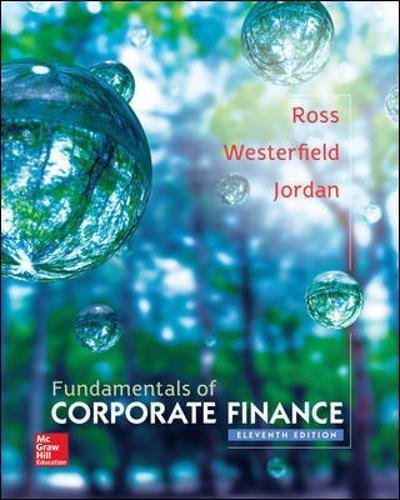Test Bank for Fundamentals of Corporate Finance 11th Edition by Ross
$55.00 Original price was: $55.00.$29.99Current price is: $29.99.
Test Bank for Fundamentals of Corporate Finance 11th Edition by Ross
Test Bank for Fundamentals of Corporate Finance 11th Edition Stephen Ross, Randolph Westerfield, Jeffrey Jaffe, Bradford Jordan 978-0077861704\

Product details:
- ISBN-10 : 9780077861759
- ISBN-13 : 978-0077861759
- Author: Jeffrey F. Jaffe
Corporate Finance, by Ross, Westerfield, Jaffe, and Jordan emphasizes the modern fundamentals of the theory of finance, while providing contemporary examples to make the theory come to life. The authors aim to present corporate finance as the working of a small number of integrated and powerful intuitions, rather than a collection of unrelated topics. They develop the central concepts of modern finance: arbitrage, net present value, efficient markets, agency theory, options, and the trade-off between risk and return, and use them to explain corporate finance with a balance of theory and application. The Eleventh Edition includes many exciting new research findings as well as an enhanced Connect Finance, now with even more student learning resources.
Table contents:
Chapter 1 Introduction to Corporate Finance 1 1.1 Corporate Finance and the Financial Manager 2 What Is Corporate Finance? 2 The Financial Manager 2 Financial Management Decisions 2 Capital Budgeting 2 Capital Structure 3 Working Capital Management 4 Conclusion 4 1.2 Forms of Business Organization 4 Sole Proprietorship 5 Partnership 5 Corporation 6 A Corporation by Another Name . . . 7 1.3 The Goal of Financial Management 8 Possible Goals 8 The Goal of Financial Management 9 A More General Goal 9 1.4 The Agency Problem and Control of the Corporation 10 Agency Relationships 10 Management Goals 10 Do Managers Act in the Stockholders? Interests? 12 Managerial Compensation 12 Control of the Firm 13 Conclusion 14 Stakeholders 14 1.5 Financial Markets and the Corporation 14 Cash Flows to and from the Firm 14 Primary versus Secondary Markets 15 Primary Markets 15 Secondary Markets 16 1.6 Summary and Conclusions 17 Chapter 2 Financial Statements, Taxes, and Cash Flow 20 2.1 The Balance Sheet 21 Assets: The Left-Hand Side 21 Liabilities and Owners? Equity: The Right-Hand Side 21 >> Net Working Capital 22 Liquidity 23 Debt versus Equity 24 Market Value versus Book Value 24 2.2 The Income Statement 25 GAAP and the Income Statement 26 Noncash Items 27 Time and Costs 27 2.3 Taxes 29 Corporate Tax Rates 29 Average versus Marginal Tax Rates 29 2.4 Cash Flow 31 Cash Flow from Assets 32 Operating Cash Flow 32 Capital Spending 33 Change in Net Working Capital 33 Conclusion 34 A Note on "Free" Cash Flow 34 Cash Flow to Creditors and Stockholders 34 Cash Flow to Creditors 34 Cash Flow to Stockholders 35 An Example: Cash Flows for Dole Cola 36 Operating Cash Flow 36 Net Capital Spending 37 Change in NWC and Cash Flow from Assets 37 Cash Flow to Stockholders and Creditors 38 2.5 Summary and Conclusions 39 PART TWO Financial Statements and Long-Term Financial Planning Chapter 3 Working with Financial Statements 48 3.1 Cash Flow and Financial Statements: A Closer Look 49 Sources and Uses of Cash 49 The Statement of Cash Flows 51 3.2 Standardized Financial Statements 53 Common-Size Statements 53 Common-Size Balance Sheets 54 Common-Size Income Statements 54 Common-Size Statements of Cash Flows 55 Common?Base Year Financial Statements: Trend Analysis 55 Combined Common-Size and Base-Year Analysis 56 ros91593_fm.qxd 12/20/04 22:06 Page xxxiii 3.3 Ratio Analysis 56 Short-Term Solvency, or Liquidity, Measures 57 Current Ratio 58 The Quick (or Acid-Test) Ratio 59 Other Liquidity Ratios 59 Long-Term Solvency Measures 60 Total Debt Ratio 60 A Brief Digression: Total Capitalization versus Total Assets 61 Times Interest Earned 61 Cash Coverage 61 Asset Management, or Turnover, Measures 62 Inventory Turnover and Days? Sales in Inventory 62 Receivables Turnover and Days? Sales in Receivables 63 Asset Turnover Ratios 64 Profitability Measures 64 Profit Margin 65 Return on Assets 65 Return on Equity 65 Market Value Measures 66 Price-Earnings Ratio 66 Market-to-Book Ratio 67 Conclusion 68 3.4 The Du Pont Identity 68 A Closer Look at ROE 68 An Expanded Du Pont Analysis 70 3.5 Using Financial Statement Information 71 Why Evaluate Financial Statements? 72 Internal Uses 72 External Uses 72 Choosing a Benchmark 72 Time-Trend Analysis 72 Peer Group Analysis 73 Problems with Financial Statement Analysis 77 3.6 Summary and Conclusions 78 Chapter 4 Long-Term Financial Planning and Growth 90 4.1 What Is Financial Planning? 91 Growth as a Financial Management Goal 91 Dimensions of Financial Planning 92 What Can Planning Acccomplish? 93 Examining Interactions 93 Exploring Options 93 Avoiding Surprises 93 Ensuring Feasibility and Internal Consistency 93 Conclusion 94 4.2 Financial Planning Models: A First Look 94 A Financial Planning Model:The Ingredients 94 Sales Forecast 94 Pro Forma Statements 94 Asset Requirements 95 Financial Requirements 95 The Plug 95 Economic Assumptions 95 A Simple Financial Planning Model 95 4.3 The Percentage of Sales Approach 97 The Income Statement 97 The Balance Sheet 98 A Particular Scenario 99 An Alternative Scenario 100 4.4 External Financing and Growth 102 EFN and Growth 104 Financial Policy and Growth 106 The Internal Growth Rate 106 The Sustainable Growth Rate 107 Determinants of Growth 108 A Note on Sustainable Growth Rate Calculations 109 4.5 Some Caveats Regarding Financial Planning Models 111 4.6 Summary and Conclusions 111 PART THREE Valuation of Future Cash Flows Chapter 5 Introduction to Valuation: The Time Value of Money 124 5.1 Future Value and Compounding 125 Investing for a Single Period 125 Investing for More Than One Period 125 A Note on Compound Growth 131 5.2 Present Value and Discounting 132 The Single-Period Case 132 Present Values for Multiple Periods 133 5.3 More on Present and Future Values 136 Present versus Future Value 136 Determining the Discount Rate 137 Finding the Number of Periods 141 5.4 Summary and Conclusions 144 Chapter 6 Discounted Cash Flow Valuation 149 6.1 Future and Present Values of Multiple Cash Flows 150 Future Value with Multiple Cash Flows 150 Present Value with Multiple Cash Flows 153 A Note on Cash Flow Timing 156 6.2 Valuing Level Cash Flows: Annuities and Perpetuities 157 Present Value for Annuity Cash Flows 157 Annuity Tables 159 Finding the Payment 160 Finding the Rate 162 Future Value for Annuities 163 A Note on Annuities Due 164 Perpetuities 165 6.3 Comparing Rates:The Effect of Compounding 167 Effective Annual Rates and Compounding 167 Calculating and Comparing Effective Annual Rates 168 EARs and APRs 170 Taking It to the Limit: A Note on Continuous Compounding 171 6.4 Loan Types and Loan Amortization 172 Pure Discount Loans 172 Interest-Only Loans 173 Amortized Loans 173 6.5 Summary and Conclusions 178 Chapter 7 Interest Rates and Bond Valuation 192 7.1 Bonds and Bond Valuation 193 Bond Features and Prices 193 Bond Values and Yields 193 Interest Rate Risk 197 Finding the Yield to Maturity: More Trial and Error 198 7.2 More on Bond Features 203 Is It Debt or Equity? 203 Long-Term Debt: The Basics 203 The Indenture 205 Terms of a Bond 205 Security 206 Seniority 206 Repayment 206 The Call Provision 207 Protective Covenants 207 7.3 Bond Ratings 208 7.4 Some Different Types of Bonds 209 Government Bonds 209 Zero Coupon Bonds 210 Floating-Rate Bonds 211 Other Types of Bonds 212 7.5 Bond Markets 214 How Bonds Are Bought and Sold 214 Bond Price Reporting 216 A Note on Bond Price Quotes 219 7.6 Inflation and Interest Rates 219 Real versus Nominal Rates 219 The Fisher Effect 220 7.7 Determinants of Bond Yields 221 The Term Structure of Interest Rates 221 Bond Yields and the Yield Curve: Putting It All Together 223 Conclusion 225 7.8 Summary and Conclusions 226 Chapter 8 Stock Valuation 233 8.1 Common Stock Valuation 234 Cash Flows 234 Some Special Cases 236 Zero Growth 236 Constant Growth 236 Nonconstant Growth 239 Components of the Required Return 241 8.2 Some Features of Common and Preferred Stocks 243 Common Stock Features 243 Shareholder Rights 243 Proxy Voting 244 Classes of Stock 245 Other Rights 245 Dividends 245 Preferred Stock Features 246 Stated Value 246 Cumulative and Noncumulative Dividends 246 Is Preferred Stock Really Debt? 247 8.3 The Stock Markets 247 Dealers and Brokers 247 Organization of the NYSE 248 Members 248 Operations 249 Floor Activity 249 NASDAQ Operations 250 NASDAQ Participants 251 Stock Market Reporting 252 8.4 Summary and Conclusions 254 PART FOUR Capital Budgeting Chapter 9 Net Present Value and Other Investment Criteria 261 9.1 Net Present Value 262 The Basic Idea 262 Estimating Net Present Value 263 9.2 The Payback Rule 266 Defining the Rule 266 Analyzing the Rule 267 Redeeming Qualities of the Rule 268 Summary of the Rule 269 9.3 The Discounted Payback 269 9.4 The Average Accounting Return 272 9.5 The Internal Rate of Return 274 Problems with the IRR 278 Nonconventional Cash Flows 278 Mutually Exclusive Investments 280 Redeeming Qualities of the IRR 282 9.6 The Profitability Index 283 9.7 The Practice of Capital Budgeting 284 9.8 Summary and Conclusions 286 Chapter 10 Making Capital Investment Decisions 295 10.1 Project Cash Flows:A First Look 296 Relevant Cash Flows 296 The Stand-Alone Principle 296 10.2 Incremental Cash Flows 296 Sunk Costs 297 Opportunity Costs 297 Side Effects 298 Net Working Capital 298 Financing Costs 298 Other Issues 299 10.3 Pro Forma Financial Statements and Project Cash Flows 299 Getting Started: Pro Forma Financial Statements 299 Project Cash Flows 300 Project Operating Cash Flow 301 Project Net Working Capital and Capital Spending 301 Projected Total Cash Flow and Value 301 10.4 More on Project Cash Flow 302 A Closer Look at Net Working Capital 302 Depreciation 305 Modified ACRS Depreciation (MACRS) 305 Book Value versus Market Value 307 An Example: The Majestic Mulch and Compost Company (MMCC) 308 Operating Cash Flows 309 Change in NWC 309 Capital Spending 310 Total Cash Flow and Value 310 Conclusion 312 10.5 Alternative Definitions of Operating Cash Flow 312 The Bottom-Up Approach 313 The Top-Down Approach 313 The Tax Shield Approach 314 Conclusion 314 10.6 Some Special Cases of Discounted Cash Flow Analysis 314 Evaluating Cost-Cutting Proposals 315 Setting the Bid Price 316 Evaluating Equipment Options with Different Lives 319 10.7 Summary and Conclusions 321 People also search: fundamentals of corporate finance 11th edition loose leaf for fundamentals of corporate finance 11th edition fundamentals of corporate finance 11th edition pdf reddit free fundamentals of corporate finance chapter 11 solutions
|
fundamentals of corporate finance 12th edition answers
|
Related products
Test Bank
Test Bank for Operating Systems: Internals and Design Principles, 7th Edition: William Stallings











